By Priyan R Naik
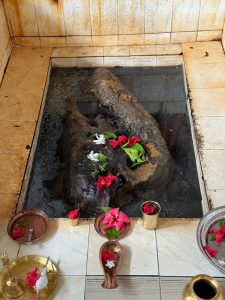 The moment one crosses over from Dawki in Meghalaya to Tamabil in Bangladesh the scenery becomes a combination of rolling hills, lush tea gardens, and the serene landscapes of the Sylhet region of Bangladesh. Known for its ‘Black Tea’, a special kind of tea made from leaves of an evergreen shrub species whose leaves produce tea, strong in taste with more caffeine, this is tea country with sprawling tea gardens on either side of the road. It was the British who discovered tea plants in Meghalaya’s Khasi and Jaintia Hills and introduced the cultivation of Black tea in Bengal and Assam’s Sylhet district.
The moment one crosses over from Dawki in Meghalaya to Tamabil in Bangladesh the scenery becomes a combination of rolling hills, lush tea gardens, and the serene landscapes of the Sylhet region of Bangladesh. Known for its ‘Black Tea’, a special kind of tea made from leaves of an evergreen shrub species whose leaves produce tea, strong in taste with more caffeine, this is tea country with sprawling tea gardens on either side of the road. It was the British who discovered tea plants in Meghalaya’s Khasi and Jaintia Hills and introduced the cultivation of Black tea in Bengal and Assam’s Sylhet district.
Historically tea production started in China’s Yunan region in the 1650s. It took 200 years, sometime around 1854, before tea was produced in the subcontinent for the first time in the Malnicherra tea garden in Sylhet. I was surprised to learn that the Malnicherra estate produces tea to this day. Close to the Sylhet airport, the garden is surrounded by greenery and is indescribably beautiful, full of pretty hills of all shapes and sizes, where one can get 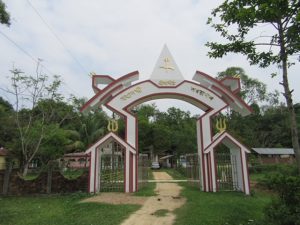 lost in beautiful carpets of green. The garden evokes memories of Bangladesh’s 1971 liberation war for it was in this very garden that the estate’s manager in-charge was abducted by Pakistani soldiers and killed. A memorial has been built to pay homage to the manager’s memory.
lost in beautiful carpets of green. The garden evokes memories of Bangladesh’s 1971 liberation war for it was in this very garden that the estate’s manager in-charge was abducted by Pakistani soldiers and killed. A memorial has been built to pay homage to the manager’s memory.
In the equally pretty Kalagul tea garden nearby is the Jayanti Kali Mandir, a temple built to worship Devi Sati. Legend has it that the death of the goddess Sati resulted in Lord Vishnu cutting her body into 51 pieces with his Sudarshan Chakra, a circular disc with sharp edges that destroys evil. Although no consensus on either the existence of the number or the whereabouts of the sites where the body parts fell survives, these supposedly fell in India, 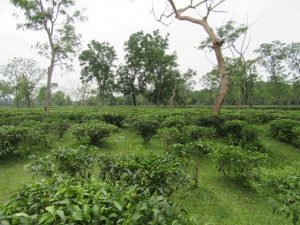 Bangladesh, Nepal, Pakistan, Tibet, Sri Lanka and Bhutan becoming sacred sites for people to pay homage to the goddess. One of Devi Sati’s 51 body parts, fell in today’s Kalagul tea estate where a temple has been built to commemorate the spot. Reputed to make the worshiper’s wishes come true, this temple has become a sacred site.
Bangladesh, Nepal, Pakistan, Tibet, Sri Lanka and Bhutan becoming sacred sites for people to pay homage to the goddess. One of Devi Sati’s 51 body parts, fell in today’s Kalagul tea estate where a temple has been built to commemorate the spot. Reputed to make the worshiper’s wishes come true, this temple has become a sacred site.
The natural beauty of the tea garden from the temple premises was panoramic. Hill after hill delicately covered with a carpet of green tea shrubs dotted the landscape. Sylhet’s tropical climate with high rainfall and nutrient-rich 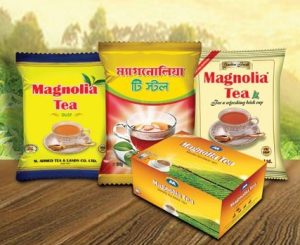 soil was the perfect recipe for high-quality black tea production known for its delicate fragrant flavor, the tender tea leaves capable of producing a delicate, light-bodied refreshing cup.
soil was the perfect recipe for high-quality black tea production known for its delicate fragrant flavor, the tender tea leaves capable of producing a delicate, light-bodied refreshing cup.
The tea plantations on the Indian side are no less. Meghalaya’s gardens are a gateway to nature’s beauty, captivating you with stunning landscapes adorned by mist-covered hills, tea shrubs, and numerous waterfalls, enveloped by the unique aroma of Meghalaya, the unparalleled natural beauty with diverse flora and fauna making for a visual treat. Grown in the hilly, cool and humid climate of the region, the tea leaves are thicker and more oxidized, resulting in an intense, and complex full-bodied flavor with earthy and sometimes slightly fruity notes. Meghalaya produces green tea in addition to black tea.
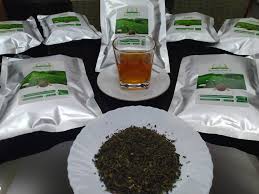 To choose between the fuller body and sweetness of Meghalaya tea and the robust and bright qualities of Sylhet tea is no easy task. Deciding which of these high-quality teas with their own distinct profiles to drink is a tough proposition. Meghalaya’s tea tends to be more robust and full-bodied, while Sylhet’s tea is more delicate and aromatic. Both types of tea have their own unique characteristics and merits. Personally, I prefer the stronger, richer taste of Meghalaya tea, while others may enjoy the more delicate, floral notes of Sylhet tea. Ultimately it is a matter of personal preference!
To choose between the fuller body and sweetness of Meghalaya tea and the robust and bright qualities of Sylhet tea is no easy task. Deciding which of these high-quality teas with their own distinct profiles to drink is a tough proposition. Meghalaya’s tea tends to be more robust and full-bodied, while Sylhet’s tea is more delicate and aromatic. Both types of tea have their own unique characteristics and merits. Personally, I prefer the stronger, richer taste of Meghalaya tea, while others may enjoy the more delicate, floral notes of Sylhet tea. Ultimately it is a matter of personal preference!
******
(Priyan R Naik is a regular contributor to The Shillong Times)



